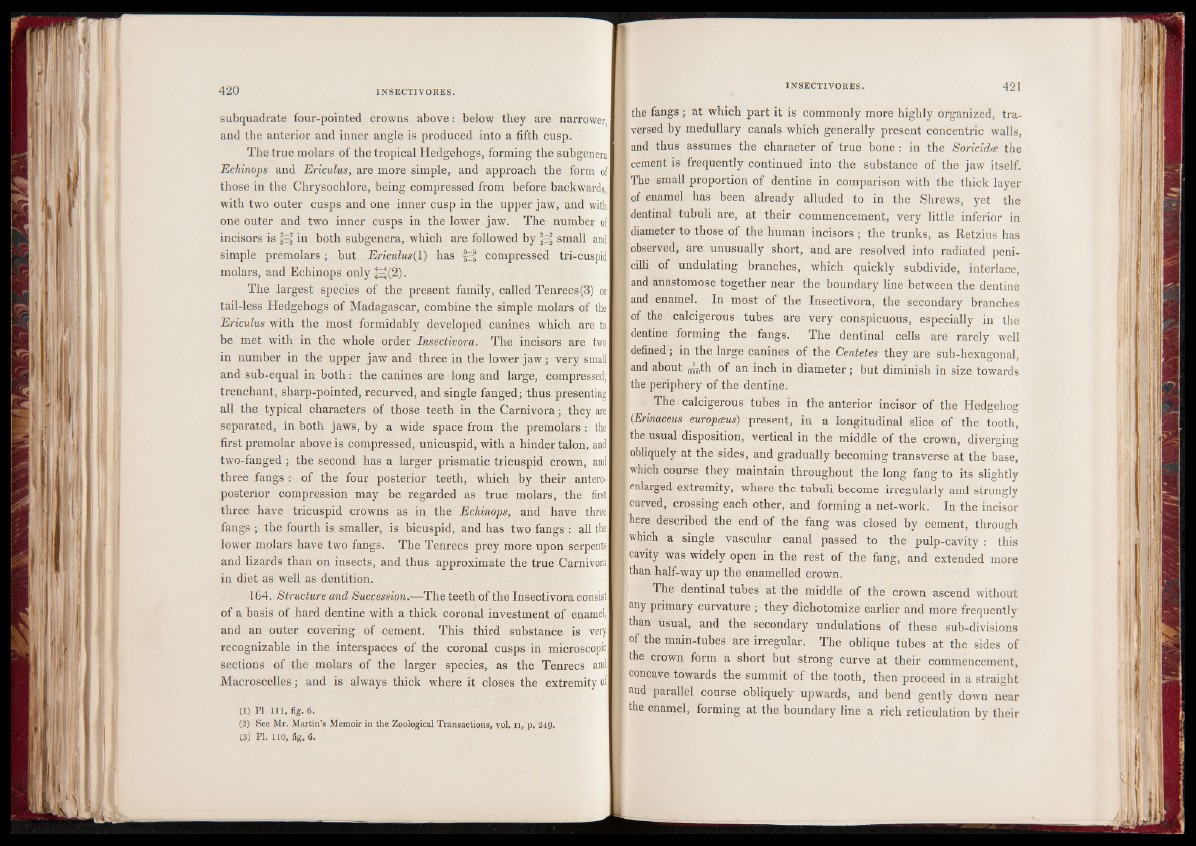
subquadrate four-pointed crowns above: below they are narrower
and the anterior and inner angle is produced into a fifth cusp.
The true molars of the tropical Hedgehogs, forming the subgenera
Echinops and Ericulus, are more simple, and approach the form of
those in the Chrysochlore, being compressed from before backwards,
with two outer cusps and one inner cusp in the upper jaw, and with
one outer and two inner cusps in the lower jaw. The number of
incisors is $$ in both subgenera, which are followed by small and
simple premolars ; but Ericulus(\) has §=§ compressed tri-cuspid
molars, and Echinops only f=2(2).
The largest species of the present family, called Tenrecs(3) or
tail-less Hedgehogs of Madagascar, combine the simple molars of the
Ericulus with the most formidably developed canines which are to
be met with in the whole order Insectivora. The incisors are two
in number in the upper jaw and three in the lower jaw; very small
and sub-equal in both: the canines are long and large, compressed,
trenchant, sharp-pointed, recurved, and single fanged; thus presenting
all the typical characters of those teeth in the Carnivora; they are
separated, in both jaws, by a wide space from the premolars: the
first premolar above is compressed, unicuspid, with a hinder talon, and
twro-fanged ; the second has a larger prismatic tricuspid crown, and
three fangs : of the four posterior teeth, which by their anteroposterior
compression may be regarded as true molars, the first
three have tricuspid crowns as in the Echinops, and have three
fangs ; the fourth is smaller, is bicuspid, and has two fangs : all the
lower molars have two fangs. The Tenrecs prey more upon serpents
and lizards than on insects, and thus approximate the true Carnivora
in diet as well as dentition.
164. Structure and Succession.-—The teeth of the Insectivora consist
of a basis of hard dentine with a thick coronal investment of enamel,
and an outer covering of cement. This third substance is very
recognizable in the interspaces of the coronal cusps in microscopic
sections of the molars of the larger species, as the Tenrecs and
Macroscelles | and is always thick where it closes the extremity of 1 2 3
(1) Pi 111, fig. 6.
(2) See Mr. Martin’s Memoir in the Zoological Transactions, vol. n, p. 249.
(3) PI. 110, fig. 6.
the fangs; at which part it is commonly more highly organized, traversed
by medullary canals which generally present concentric walls,
and thus assumes the character of true bone : in the Soricides the
cement is frequently continued into the substance of the jaw itself.
The small proportion of dentine in comparison with the thick layer
i of enamel has been already alluded to in the Shrews, yet the
I dentinal tubuli are, at their commencement, very little inferior in
I diameter to those of the human incisors ; the trunks, as Retzius has
I observed, are unusually short, and are resolved into radiated peni-
I cilli of undulating branches, which quickly subdivide, interlace,
I and anastomose together near the boundary line between the dentine
I and enamel. In most of the Insectivora, the secondary branches
I of the calcigerous tubes are very conspicuous, especially in the
■ dentine forming the fangs. The dentinal cells are rarely well
I defined; in the large canines of the Centetes they are sub-hexagonal,
I and about j^th of an inch in diameter; but diminish in size towards
I the periphery of the dentine.
The . calcigerous tubes in the anterior incisor of the Hedgehog
I {Erinaceus europceus) present, in a longitudinal slice of the tooth,
I the usual disposition, vertical in the middle of the crown, diverging
I obliquely at the sides, and gradually becoming transverse at the base,
I which course they maintain throughout the long fang to its slightly
I enlarged extremity, where the tubuli become irregularly and strongly
I curved, crossing each other, and forming a net-work. In the incisor
here described the end of the fang was closed by cement, through
which a single vascular canal passed to the pulp-cavity f this
cavity was widely open in the rest of the fang, and extended more
than half-way up the enamelled crown.
The dentinal tubes at the middle of the crown ascend without
| any primary curvature ; they dichotomize earlier and more frequently
i than usual, and the secondary undulations of these sub-divisions
of the main-tubes are irregular. The oblique tubes at the sides of
the crown form a short but strong curve at their commencement,
concave towards the summit of the tooth, then proceed in a straight
and parallel course obliquely upwards, and bend gently down near
the enamel, forming at the boundary line a rich reticulation by their